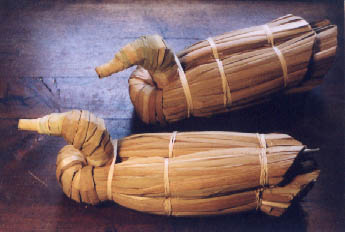

For thousands of years, Natives Americans across North America used cattails, other grasses, and rushes for items of everyday use. One of the most ingenious uses of cattail, bulrush and the tule plant was making floating decoys to lure waterfowl to roosting areas to be bow-hunted, netted, or snared. Geese and other migratory birds, passenger pigeon, cormorant, swan, and as well as turkey, grouse, partridge were important game birds to Native Americans. In New England, the Nipmuc (which means 'fresh water people') have traditional territory in land-locked areas, away from the seacoast. Non-coastal, interior woodland groups set up their base camps and villages around rich lake sides, ponds and rivers that attracted ducks and other game.

|
Decoys from Lovelock Cave were made from tule reed, a plant species related to bulrush. There are many varieties of bulrush, a round hollow, tall reed which grows around wetlands across North America. Unfortunately, some more resilient European introduced plants like phragmities reed and purple loosestrife have squeezed out many colonies of indigenous plants like bulrush.
Similar floating decoys were undoubtedly made by Native Americans in the East. Today, Cree Indians around the northern Great Lakes make standing goose decoys from flexible tamarack sticks. Chippewa Indians make floating toy decoys, only a few inches in length, from single cattail leaves for their children.


© 1994 - Tara Prindle